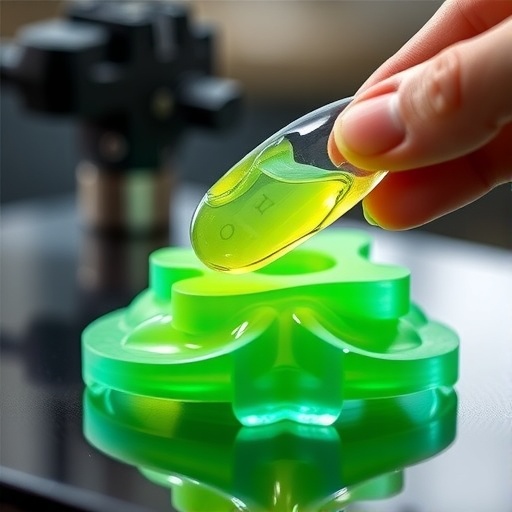
Researchers at the University of Texas at Austin have recently unveiled a groundbreaking advancement in the field of three-dimensional (3D) printing, drawing inspiration from the duality of nature’s structural compositions, such as the robustness of bone juxtaposed with the resilience of cartilage. This innovative technique involves the integration of both soft and hard materials into a single object, utilizing a novel approach that employs varied wavelengths of light as initiators of the printing process. The findings, published in the prestigious journal Nature Materials, set a new paradigm for the capabilities of additive manufacturing by combining flexibility and strength in ways previously deemed unattainable.
The significant potential of this technique lies in its application for a range of next-generation technologies, from prosthetics designed to mimic human movement to adaptable medical devices and elastic electronics. The researchers’ novel method could revolutionize industries by allowing for the smart design of materials that interact seamlessly with the human body, enhancing comfort and usability in applications that demand both durability and adaptability. This dual-material printing approach endeavors to emulate biological systems delicately balanced between rigidity and flexibility, providing insights into a fundamental aspect of material science.
Assistant professor Zak Page led the research, highlighting that the researchers were motivated by nature’s ability to unite hard and soft materials while maintaining structural integrity. “Nature achieves this amalgamation organically. Our objective was to translate that phenomenon into a manufacturing process that can be replicated,” Page explained. This drive to explore and harness natural principles aligns with the objective of expanding the functionality and applicability of 3D printing, marking a notable step toward more sophisticated manufacturing solutions.
.adsslot_ua4DeRqOzo{ width:728px !important; height:90px !important; }
@media (max-width:1199px) { .adsslot_ua4DeRqOzo{ width:468px !important; height:60px !important; } }
@media (max-width:767px) { .adsslot_ua4DeRqOzo{ width:320px !important; height:50px !important; } }
ADVERTISEMENT
Innovation in 3D printing is not a novel pursuit, but the integration of diverse material properties within a single print session represents a significant departure from traditional methods. The printing technique relies on a custom-engineered resin that responds uniquely to different molds of light exposure. A violet light beams down to enable the curing of a flexible, rubber-like material, while a more potent ultraviolet light hardens the resin into a strong, robust substance. This unique process facilitates the creation of objects with differentiated tactile characteristics, ensuring a smooth transition between soft and hard regions in a level of detail that traditional techniques struggle to achieve.
One of the critical challenges in manufacturing multi-material objects lies in the propensity for material failure at the interfaces where disparate materials meet. Think of more conventional products, like running shoes, whereby the various components begin to separate as they are subjected to stress. The innovative 3D printing method addresses this weakness by integrating a chemical interface that allows soft and hard materials to “communicate” effectively, which strengthens the connection and can yield a gradual transition between the properties, forming a much more resilient structure.
Demonstrating the capability of their system, the researchers successfully printed a functional knee joint with pliable ligaments and rigid bone components that moved in unison, reflecting a remarkable range of natural movement. Furthermore, they engineered a prototype for a flexible electronic device with a gold wire embedded in a stretching strip; this device was designed with an extremely flexible area while ensuring stronger, rigid sections remained intact to avoid breakage during everyday use. These prototypes are emblematic of how this method can bridge the gap between rigid and flexible demands in modern applications.
Another critical aspect that emerged during the research was the unexpected efficiency achieved during the initial trials of this 3D printing method. Page noted how promising the outcome was, stating, “Honestly, what surprised me most was how well it worked on the first try. That almost never happens with 3D printing resins.” This encouraged the researchers to delve further into the implications of their findings, which show that the soft components can stretch substantially, reminiscent of a rubber band, before smoothly reverting to their original shape, while the hard components boast strength that rivals conventional consumer products.
Speed and resolution are two additional benefits the new printing technique offers, presenting a faster production time and improving detail when compared to predecessors. Given that the required printer configuration is user-friendly and not excessively pricey, there is a potential for wide accessibility for institutions like hospitals, universities, and independent researchers. This democratization of technology could lead to advancements in a myriad of sectors, including healthcare, academia, and engineering.
The versatile nature of this terrain in 3D printing implies that the potential applications for the newly developed method are vast and varied. For instance, it could serve a pivotal role in creating surgical models that can be tailored to individual patients or manufacturing wearable sensors that seamlessly interact with the body’s movements. Additionally, the usage in soft robotics shows tremendous promise, allowing for the development of machines that better mimic organic movements and respond to varied environments.
The collaborative work seen in this endeavor signifies the importance of interdisciplinary research in driving innovation. The research team, including contributors like Keldy Mason, demonstrated not only technical capabilities but also an integrative approach to material science, chemistry, and engineering. Their combined efforts were recognized in related publications; one notable piece published in ACS Central Science explored adjunct aspects of their research, garnering acclaim for representing possibly the future landscape of 3D printing.
Funding from prominent organizations such as the U.S. Department of Defense, the Robert A. Welch Foundation, and the National Science Foundation highlights the importance and utility of their research. The support from these institutions not only underscores the value of the work but also suggests a broader interest in advancing manufacturing techniques that align with today’s complex design and production demands.
As the research continues to evolve, this newfound methodology appears poised not merely to augment existing technologies but to essentially redefine possibilities within the space of materials science. It represents a specific potential to address larger questions around sustainability, performance, and the future of production in a world increasingly reliant on additive manufacturing solutions.
In the overall context of scientific and technological advancements, the implications of this groundbreaking research extend far beyond 3D printing itself. The research continues to inspire a wave of creativity, urging scientists and innovators to rethink possibilities and push the boundaries of what can be achieved through the smart application of light and material properties. As researchers continue to refine this technique, the horizon for printed materials becomes increasingly expansive and inviting.
This research journey reflects the intricate dance between age-old inspiration drawn from Nature and the contemporary technological innovations of today, reiterating that the potential to shape the future often lies in understanding and replicating fundamental processes found within the natural world. This emerging printing technology stands at the intersection of biology, engineering, and design, inviting excitement and curiosity about what lies ahead in the evolution of materials science.
Subject of Research: Not applicable
Article Title: Hybrid epoxy–acrylate resins for wavelength-selective multimaterial 3D printing
News Publication Date: June 30, 2025
Web References: Not available
References: Not available
Image Credits: The University of Texas at Austin
Keywords
Materials science
Chemistry
Tags: 3D printing advancementsadditive manufacturing breakthroughsadvanced material control in 3D printingapplications of 3D printing in prostheticsbiomimicry in engineeringdual-material printing techniqueselastic electronics developmentenhanced usability in 3D printed productsflexible and strong materialsinnovative 3D printing methodsnature-inspired material designnext-generation medical devices



